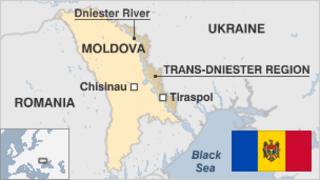Moldova country profile
Sandwiched between Romania and Ukraine, Moldova emerged as an independent republic following the collapse of the Soviet Union in 1991.
Moldova is one of the poorest countries in Europe, with its economy relying heavily on agriculture.
Two-thirds of Moldovans are of Romanian descent, and the two countries share a common cultural heritage.
The industrialised territory to the east of the Dniester, generally known as Trans-Dniester or the Dniester region, was formally an autonomous area within Ukraine before 1940, when the Soviet Union combined it with Bessarabia to form the Moldavian Soviet Socialist Republic.
This area is mainly inhabited by Russian- and Ukrainian-speakers. As people there became increasingly alarmed at the prospect of closer ties with Romania in the tumultuous twilight years of the Soviet Union, Trans-Dniester unilaterally declared independence from Moldova in 1990.
Fierce fighting followed. Trans-Dniester’s independence has never been recognised and the region has existed in a state of limbo ever since.
FACTS
Republic of Moldova
Capital: Chisinau
Population 3.5 million
Area 33,800 sq km (13,050 sq miles)
Major languages Romanian (called "Moldovan" in official documents), Russian
Major religion Christianity
Life expectancy 66 years (men), 73 years (women)
Currency leu
LEADERS
President: Igor Dodon
Pro-Russian candidate Igor Dodon was elected president in November 2016, beating pro-European rival Maia Sandu with 55% of the vote.
His election marked the first time in 16 years that Moldova’s head of state was chosen directly by the people and not by parliament.
During his election campaign, Mr Dodon pledged to end Moldova’s seven-year flirtation with the European Union and steer his country back towards Russia.
In 2015, Moldova was wracked by a banking scandal leading to deep public discontent over high-level corruption and poor living standards.
A former economics minister, Mr Dodon has led the Party of Socialists since 2011.
Prime Minister: Maia Sandu
The pro-European politician Maia Sandu formed a coalition government in June 2019, ending months of stalemate after inconclusive elections in February.Her liberal Party of Action and Solidarity has allied with the pro-Russian Socialist Party to focus on strengthening ties with the European Union and prosecuting suspects in a long-running scandal over the embezzlement of $1bn, 12.5% of the country’s GDP, from the banking system.
Ms Sandu has worked at the World Bank and served as education minister in 2012-2015, before losing the presidential election in 2016.
MEDIA
The internet is the second most important source of news after TV. Around 70% of Moldovans are online.
The top social network is Russia’s Odnoklassniki, followed by Facebook.
Political battles between pro-Russia and pro-West camps are played out in the media.
TIMELINE
1924 – Moldovan Autonomous Soviet Socialist Republic established east of the Dniester River within Ukraine.
1940 – Russia annexes Bessarabia from Romania, and combines it with most of the Moldovan Autonomous Soviet Socialist Republic to form Moldavian Soviet Socialist Republic.
1991 – Moldova declares independence. It joins the Commonwealth of Independent States, the successor to the Soviet Union.
2001 – The elections see the communists under Vladimir Voronin win just over 50% of the vote.
2014 – Moldova signs association agreement with the European Union, prompting Russia to impose import restrictions on the country’s agricultural produce.
2015 – National Bank uncovers official inaction over embezzlement of $1bn – about 12.5% of annual GDP – from the banking system, prompting a major political crisis and credit crunch.
Source: Read Full Article



